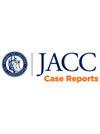冠状动脉异常主动脉起源的多模态成像
Q4 Medicine
引用次数: 0
摘要
背景:冠状动脉主动脉异常(AAOCA)是一种罕见的先天性异常,与心肌缺血和心源性猝死的风险增加有关,特别是在遭受极端生理应激的运动员中。高度活跃个体的诊断和治疗策略仍然具有挑战性,并且代表着重要的知识空白。我们报告了4例具有多种特征的优秀运动员AAOCA,并详细介绍了他们的临床评估、影像学和功能评估、风险分层、治疗决策和纵向随访。关于AAOCA运动员管理的前瞻性数据有限。尸检研究已经确定年轻(35岁)、高运动水平和心肌纤维化是心源性猝死的危险因素。此外,欧洲心脏病学会关于成人先天性心脏病建议在风险评估中包括年龄、运动水平和高危异常特征的存在。本系列文章强调了管理运动员AAOCA的复杂性,并强调了在多学科、个性化决策的背景下进行多模态成像的必要性。多模态成像方法对于AAOCA的早期识别、风险分层和临床决策至关重要。治疗决定应基于症状、高危特征的存在和使用互补成像方式诱导缺血,并由多学科运动心脏病学团队提供个性化建议。本文章由计算机程序翻译,如有差异,请以英文原文为准。
Multimodality Imaging in Anomalous Aortic Origin of the Coronary Arteries
Background
Anomalous aortic origin of a coronary artery (AAOCA) is a rare congenital anomaly linked to increased risk of myocardial ischemia and sudden cardiac death, especially among athletes subjected to extreme physiological stress. The diagnostic and therapeutic strategies in highly active individuals remain challenging and represent important knowledge gaps.
Case Summary
We present 4 cases of elite athletes with AAOCA with a variety of characteristics and detail their clinical evaluation, imaging and functional assessment, risk stratification, treatment decisions, and longitudinal follow-up.
Discussion
There are limited prospective data regarding the management of AAOCA in athletes. Autopsy studies have identified young age (<35 years), high exercise levels, and myocardial fibrosis as risk factors for sudden cardiac death. Moreover, the European Society of Cardiology on adult congenital heart disease recommends including age, level of exercise, and presence of high-risk anomaly features in risk assessment. This series highlights the complexities of managing AAOCA in athletes, and emphasizes the necessity for multimodality imaging in a context of multidisciplinary, individualized decision-making.
Take-Home Messages
A multimodality imaging approach is essential for early recognition, risk stratification, and clinical decision-making in AAOCA. Treatment decisions should be based on symptoms, presence of high-risk features, and inducible ischemia using complementary imaging modalities, with personalized recommendations supported by a multidisciplinary sports cardiology team.
求助全文
通过发布文献求助,成功后即可免费获取论文全文。
去求助
来源期刊

JACC. Case reports
Medicine-Cardiology and Cardiovascular Medicine
CiteScore
1.30
自引率
0.00%
发文量
404
审稿时长
17 weeks
 求助内容:
求助内容: 应助结果提醒方式:
应助结果提醒方式:


